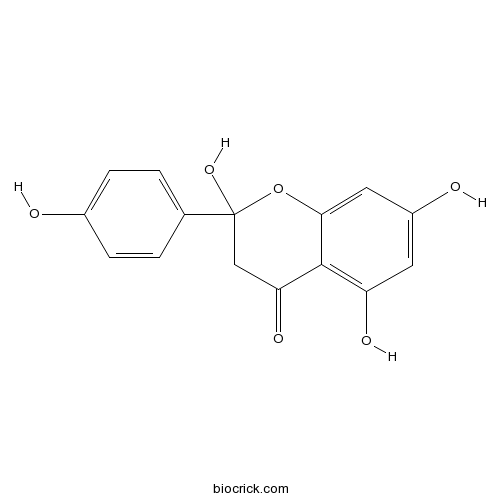2-HydroxynaringeninCAS# 58124-18-8 |

Quality Control & MSDS
3D structure
Package In Stock
Number of papers citing our products

| Cas No. | 58124-18-8 | SDF | Download SDF |
| PubChem ID | 21932272 | Appearance | Powder |
| Formula | C15H12O6 | M.Wt | 288.3 |
| Type of Compound | Flavonoids | Storage | Desiccate at -20°C |
| Solubility | Soluble in Chloroform,Dichloromethane,Ethyl Acetate,DMSO,Acetone,etc. | ||
| Chemical Name | 2,5,7-trihydroxy-2-(4-hydroxyphenyl)-3H-chromen-4-one | ||
| SMILES | C1C(=O)C2=C(C=C(C=C2OC1(C3=CC=C(C=C3)O)O)O)O | ||
| Standard InChIKey | NFENYLPEYDNIMO-UHFFFAOYSA-N | ||
| General tips | For obtaining a higher solubility , please warm the tube at 37 ℃ and shake it in the ultrasonic bath for a while.Stock solution can be stored below -20℃ for several months. We recommend that you prepare and use the solution on the same day. However, if the test schedule requires, the stock solutions can be prepared in advance, and the stock solution must be sealed and stored below -20℃. In general, the stock solution can be kept for several months. Before use, we recommend that you leave the vial at room temperature for at least an hour before opening it. |
||
| About Packaging | 1. The packaging of the product may be reversed during transportation, cause the high purity compounds to adhere to the neck or cap of the vial.Take the vail out of its packaging and shake gently until the compounds fall to the bottom of the vial. 2. For liquid products, please centrifuge at 500xg to gather the liquid to the bottom of the vial. 3. Try to avoid loss or contamination during the experiment. |
||
| Shipping Condition | Packaging according to customer requirements(5mg, 10mg, 20mg and more). Ship via FedEx, DHL, UPS, EMS or other couriers with RT, or blue ice upon request. | ||
| Description | 1. The recombinant protein exhibits high FNS I activity catalyzing the conversion of naringenin to apigenin and 2-Hydroxynaringenin. |

2-Hydroxynaringenin Dilution Calculator

2-Hydroxynaringenin Molarity Calculator
| 1 mg | 5 mg | 10 mg | 20 mg | 25 mg | |
| 1 mM | 3.4686 mL | 17.343 mL | 34.6861 mL | 69.3722 mL | 86.7152 mL |
| 5 mM | 0.6937 mL | 3.4686 mL | 6.9372 mL | 13.8744 mL | 17.343 mL |
| 10 mM | 0.3469 mL | 1.7343 mL | 3.4686 mL | 6.9372 mL | 8.6715 mL |
| 50 mM | 0.0694 mL | 0.3469 mL | 0.6937 mL | 1.3874 mL | 1.7343 mL |
| 100 mM | 0.0347 mL | 0.1734 mL | 0.3469 mL | 0.6937 mL | 0.8672 mL |
| * Note: If you are in the process of experiment, it's necessary to make the dilution ratios of the samples. The dilution data above is only for reference. Normally, it's can get a better solubility within lower of Concentrations. | |||||

Calcutta University

University of Minnesota

University of Maryland School of Medicine

University of Illinois at Chicago

The Ohio State University

University of Zurich

Harvard University

Colorado State University

Auburn University

Yale University

Worcester Polytechnic Institute

Washington State University

Stanford University

University of Leipzig

Universidade da Beira Interior

The Institute of Cancer Research

Heidelberg University

University of Amsterdam

University of Auckland

TsingHua University

The University of Michigan

Miami University

DRURY University

Jilin University

Fudan University

Wuhan University

Sun Yat-sen University

Universite de Paris

Deemed University

Auckland University

The University of Tokyo

Korea University
- SU 4312
Catalog No.:BCC7073
CAS No.:5812-07-7
- Aurantiamide
Catalog No.:BCN5790
CAS No.:58115-31-4
- 1-(4-(3-Chloropropoxy)-3-methoxyphenyl)ethanone
Catalog No.:BCC8406
CAS No.:58113-30-7
- Fmoc-Arg(NO2)-OH
Catalog No.:BCC2596
CAS No.:58111-94-7
- Undulatoside A
Catalog No.:BCN6773
CAS No.:58108-99-9
- Isonicoteine
Catalog No.:BCN2152
CAS No.:581-50-0
- Anatabine
Catalog No.:BCN6899
CAS No.:581-49-7
- Suberosin
Catalog No.:BCN5791
CAS No.:581-31-7
- α-MSH
Catalog No.:BCC7420
CAS No.:581-05-5
- trans-3,4-Methylenedioxycinnamyl alcohol
Catalog No.:BCN1410
CAS No.:58095-76-4
- Miltefosine
Catalog No.:BCC4360
CAS No.:58066-85-6
- 24, 25-Dihydroxy VD2
Catalog No.:BCC1302
CAS No.:58050-55-8
- NSC 207895 (XI-006)
Catalog No.:BCC2243
CAS No.:58131-57-0
- Militarine
Catalog No.:BCN2551
CAS No.:58139-23-4
- Ethyl 5-amino-4-cyano-3-(2-ethoxy-2-oxoethyl)thiophene-2-carboxylate
Catalog No.:BCC8975
CAS No.:58168-20-0
- Idebenone
Catalog No.:BCC4913
CAS No.:58186-27-9
- H-DL-Ser-OMe.HCl
Catalog No.:BCC3100
CAS No.:5819-04-5
- Tetraethyl ranelate
Catalog No.:BCC9177
CAS No.:58194-26-6
- Betulin palmitate
Catalog No.:BCN5792
CAS No.:582315-55-7
- BMS265246
Catalog No.:BCC3741
CAS No.:582315-72-8
- ICA 069673
Catalog No.:BCC7911
CAS No.:582323-16-8
- Kakkalide
Catalog No.:BCN8263
CAS No.:58274-56-9
- Nanaomycin C
Catalog No.:BCC4016
CAS No.:58286-55-8
- Kusunokinin
Catalog No.:BCN3226
CAS No.:58311-20-9
Functional characterization of a Plagiochasma appendiculatum flavone synthase I showing flavanone 2-hydroxylase activity.[Pubmed:24859082]
FEBS Lett. 2014 Jun 27;588(14):2307-14.
FNS I is a 2-oxoglutarate dependent dioxygenase (2-ODD) found mainly in species of the Apiaceae family. Here, an FNS I cDNA sequence was isolated from the liverwort Plagiochasma appendiculatum (Aytoniaceae) and characterized. The recombinant protein exhibited high FNS I activity catalyzing the conversion of naringenin to apigenin and 2-Hydroxynaringenin. The critical residue for flavanone-2-hydroxylation activity was Tyr240, as identified from homology modeling and site-directed mutagenesis. The recombinant protein also showed some flavonol synthase activity, as it can convert dihydrokaempferol to kaempferol. When the Leu311 residue was mutated to Phe, the enzyme's capacity to convert dihydrokaempferol to kaempferol was substantially increased. PaFNS I represents a 2-ODD in which a hydrophobic pi-stacking interaction between the key residue and the naringenin A-ring determines 2-hydroxyflavanone formation.


